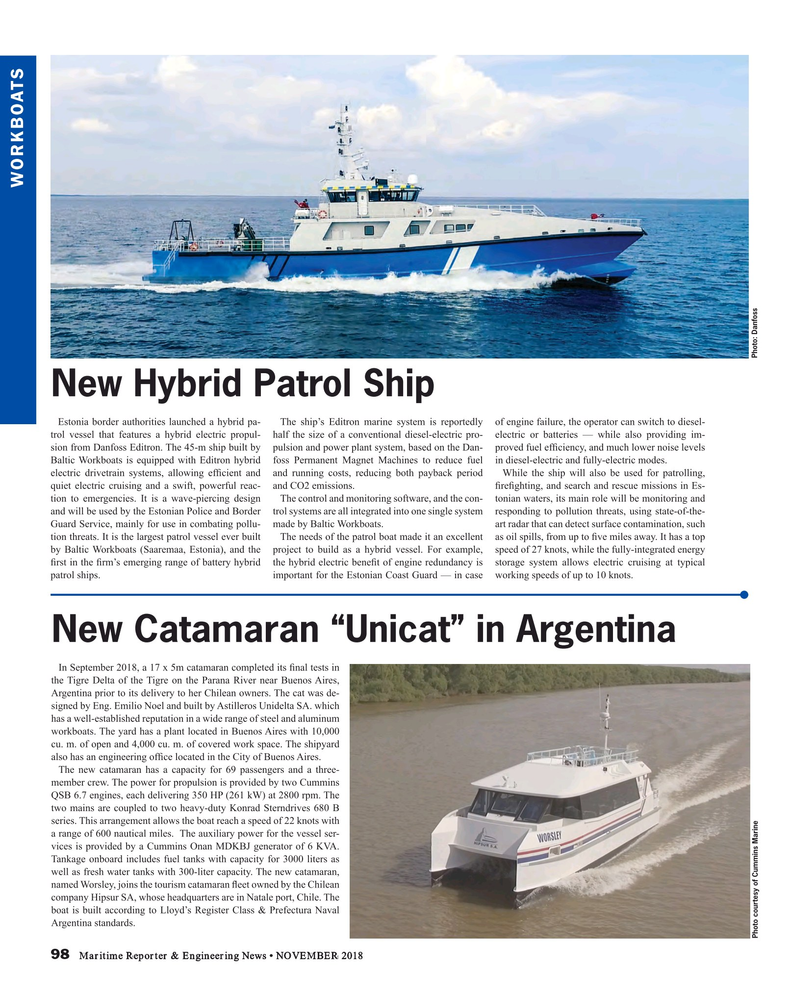
Page 98: of Maritime Reporter Magazine (November 2018)
Workboat Edition
Read this page in Pdf, Flash or Html5 edition of November 2018 Maritime Reporter Magazine
WORKBOATS
New Hybrid Patrol Ship
Estonia border authorities launched a hybrid pa- The ship’s Editron marine system is reportedly of engine failure, the operator can switch to diesel- trol vessel that features a hybrid electric propul- half the size of a conventional diesel-electric pro- electric or batteries — while also providing im- sion from Danfoss Editron. The 45-m ship built by pulsion and power plant system, based on the Dan- proved fuel ef? ciency, and much lower noise levels
Baltic Workboats is equipped with Editron hybrid foss Permanent Magnet Machines to reduce fuel in diesel-electric and fully-electric modes.
electric drivetrain systems, allowing ef? cient and and running costs, reducing both payback period While the ship will also be used for patrolling, quiet electric cruising and a swift, powerful reac- and CO2 emissions. ? re? ghting, and search and rescue missions in Es- tion to emergencies. It is a wave-piercing design The control and monitoring software, and the con- tonian waters, its main role will be monitoring and and will be used by the Estonian Police and Border trol systems are all integrated into one single system responding to pollution threats, using state-of-the-
Guard Service, mainly for use in combating pollu- made by Baltic Workboats. art radar that can detect surface contamination, such tion threats. It is the largest patrol vessel ever built The needs of the patrol boat made it an excellent as oil spills, from up to ? ve miles away. It has a top by Baltic Workboats (Saaremaa, Estonia), and the project to build as a hybrid vessel. For example, speed of 27 knots, while the fully-integrated energy ? rst in the ? rm’s emerging range of battery hybrid the hybrid electric bene? t of engine redundancy is storage system allows electric cruising at typical patrol ships. important for the Estonian Coast Guard — in case working speeds of up to 10 knots.
New Catamaran “Unicat” in Argentina
In September 2018, a 17 x 5m catamaran completed its ? nal tests in the Tigre Delta of the Tigre on the Parana River near Buenos Aires,
Argentina prior to its delivery to her Chilean owners. The cat was de- signed by Eng. Emilio Noel and built by Astilleros Unidelta SA. which has a well-established reputation in a wide range of steel and aluminum workboats. The yard has a plant located in Buenos Aires with 10,000 cu. m. of open and 4,000 cu. m. of covered work space. The shipyard also has an engineering of? ce located in the City of Buenos Aires.
The new catamaran has a capacity for 69 passengers and a three- member crew. The power for propulsion is provided by two Cummins
QSB 6.7 engines, each delivering 350 HP (261 kW) at 2800 rpm. The two mains are coupled to two heavy-duty Konrad Sterndrives 680 B series. This arrangement allows the boat reach a speed of 22 knots with a range of 600 nautical miles. The auxiliary power for the vessel ser- vices is provided by a Cummins Onan MDKBJ generator of 6 KVA.
Tankage onboard includes fuel tanks with capacity for 3000 liters as well as fresh water tanks with 300-liter capacity. The new catamaran, named Worsley, joins the tourism catamaran ? eet owned by the Chilean company Hipsur SA, whose headquarters are in Natale port, Chile. The boat is built according to Lloyd’s Register Class & Prefectura Naval
Argentina standards.
Photo courtesy of Cummins Marine Photo: Danfoss 98 Maritime Reporter & Engineering News • NOVEMBER 2018
MR #11 (98-105).indd 98 MR #11 (98-105).indd 98 11/6/2018 9:54:00 AM11/6/2018 9:54:00 AM

 97
97

 99
99
